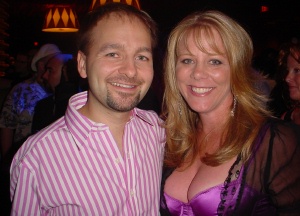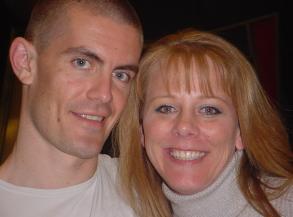|
 "I'm
not a household name, like 'fork'." -- Tom Waits "I'm
not a household name, like 'fork'." -- Tom Waits
As I mention in the Sponsored Poker Players article, during the first commercial
break of the first World Poker Tour broadcast in 2003, I put up a "Shana Hiatt" page on my old domain. By dawn the next morning I ranked
#1 for [Shana Hiatt] searches and got 2000 visitors that day from people who searched for [Shana Hiatt].
Online Poker Entrepreneurial Innovation to Corporate Verticals
explains how this lead me to ask my friend Shirley Rosario if she would be interested
in partnering on a female-fronted poker site. While we both wanted to focus on her adventures as a female player in the overwhelmingly male poker world,
Shirley wanted to build the initial bulk of the site around profiles of successful poker players, especially those appearing on World Poker Tour and
World Series of Poker broadcasts. I thought she was nuts, since nobody had ever given a crap about poker players before, but we did need to open the
site with at least several dozens of pages of original content, so I agreed. As it turns out, her instinct was spot on. After seeing poker on TV,
people were interested in learning more about these players.
Johnny Chan and Amarillo Slim were the only players the
public ever heard of prior to the first WPT broadcast. They were the poker equivalent of Willie Mosconi and Minnesota Fats. But that was it.
No poker player had anything like the fame of chess champion Bobby Fischer or bookmaker Jimmy the Greek. When a guy shot in 1876 (Wild Bill
Hickok) is the most familiar person in your Hall of Fame, you know your industry is kinda anonymous.
There were some players who were well known within the industry, like authors Doyle Brunson and David Sklansky. Mike Caro and Roy Cooke were associated
with Planet Poker, the first online poker site. Phil Hellmuth, Annie Duke, Russ Hamilton and Mansour Matloubi were founders of UltimateBet,
and Mike Sexton fronted Party Poker... but hardly anyone was burning up the search boxes with these names prior to the first WPT broadcast.
By the time we got Shirley's site up though... there were thousands of poker player searches everyday. Without question the name with the highest
volume of searches initially was Chris Moneymaker. And how do I know that? Two reasons. One reason is Google's "Google Trends" when it
debuted in 2006 had data going back a couple years. The other reason is simple...
When Shirley's site went online in fall 2003 there were literally no other sites with bio information about poker players, beyond tournament
result lists. Phil Hellmuth, Doyle Brunson and Daniel Negreanu and a few others had their own sites. The Hendon Mob had a website for the
four players, but the database didn't come online until 2004. Even the Wikipedia didn't have player bios until late 2004 (which were
usually built primarily with information from Shirley's site and the Hendon Mob stats).
So, for the first 18 months of the poker boom, Shirley's site generally ranked #1 for a search for any poker player (besides the rare
exceptions above who had their own sites). This meant she and I had access to the website statistics which showed how many visitors we
would get each day from searches for every player. We had a page for most of the initial wave of high profile players, but there were a few we
didn't get around to or didn't want to write about. This data gave us unique insight into player popularity -- and especially longterm
popularity. (Some of the more clownish players would have spikes of popularity, but usually not steady day-in, day-out interest.)
 Searches
in 2003 for Chris Moneymaker dwarfed everybody else. For the first year and a half her site was up, Moneymaker was Shirley's best moneymaker,
and she still loves him because of that! He still remained the #1 player search in 2004, but after the initial novelty wore off, Moneymaker
was only a bit more popular than a trio of players: Daniel Negreanu, Phil Ivey and Gus Hansen. Greg "Fossilman" Raymer was next,
due to his winning the 2004 WSOP main event, but he didn't hold that level of popularity into 2005 and beyond. Searches
in 2003 for Chris Moneymaker dwarfed everybody else. For the first year and a half her site was up, Moneymaker was Shirley's best moneymaker,
and she still loves him because of that! He still remained the #1 player search in 2004, but after the initial novelty wore off, Moneymaker
was only a bit more popular than a trio of players: Daniel Negreanu, Phil Ivey and Gus Hansen. Greg "Fossilman" Raymer was next,
due to his winning the 2004 WSOP main event, but he didn't hold that level of popularity into 2005 and beyond.
There was a significant drop-off to the next name on the list, a name that surprised me as I prepared to write this article...
Howard Lederer. Even though the 2004 WSOP broadcasts featured him, it's still surprising that he got more than twice as many
searches as Chris Ferguson, Paul Phillips, Scotty Nguyen or any other male player further down the list. Phil Hellmuth also was in the
ballpark of Chris/Paul/Scotty, but remember, we only ranked second for him after his own site, so I expect his searches were
actually at a level above Howard and around Fossilman, but probably below the top four of Chris/Daniel/Ivey/Gus.
After Lederer but before Chris/Paul/Scotty came Annie Duke and Evelyn Ng. On my website, searches for Shana Hiatt in 2004 fell to about 1/3
of their level in 2003, but Shana searches still generated to my site about five times the number of people who went to Shirley's site
via searches for Moneymaker. I can't make the point strongly enough that people who searched for poker personalities during the boom searched
disproportionately for women. Clonie Gowen, Jennifer Harman, Isabelle Mercier, Kathy Liebert, Cyndy Violette and especially Erin Ness all performed
consistently well. Even the obscure search of [Cycalona Gowen] brought more traffic than fairly high profile men like Andy Bloch or Erick Lindgren.
Besides player bio pages, Shirley also wrote reports on each World Poker Tour broadcast for the first three seasons, so those would attract
player searches for people that would suddenly come into the general public's view for the first time, like Juha Helppi or Tony Guoga.
It was interesting to observe which players made a strong initial impression, and then also which achieved longer term popularity.
By 2006, the Wikipedia began consistently taking the #1 search slot for players who didn't have their own websites, and Full Tilt
Poker was putting up sites for their players, so Shirley's site now had to settle for ranking #2 or #3 for most players. On top of that,
all sorts of websites were using information from her profiles to make their own player pages. (One bottom-feeding spammer even put up
165 different websites with copies of her profiles.) We still laugh when we see around the Internet some nearly word-for-word obscure
fact Shirley originally wrote years ago, like Amir Vahedi poker coaching Ben Affleck or Vanessa Rousso promoting charity golf before law school.
Some player's popularity was a little harder to track than others because of the wide variety of ways people would search for them. Gus Hansen,
Gus Hanson, Gustav/Gustavo Hanson. Jennifer Harman/Harmon. Stu Ungar/Unger. Cyndi/Cindy Violette. [Phil Gordon poker] was relatively more important
than [Phil Hellmuth poker], since no one needed to be more specific with Hellmuth, but the mayor of Phoenix was also named Phil Gordon.
We got a great deal more traffic by translating the bios into several languages, but
the old Full Tilt business model helped kill poker biography
searches as a major traffic source, since they associated with so many players, but I can't pass by this point without highlighting again how
their business model was so flawed. Some players were good at attracting traffic, but after 2006, aside from the second tier of Ferguson/Harman/Hansen,
Phil Ivey basically attracted more traffic himself than the rest of Team Full Tilt put together. It was a waste to devote anything like the
same ballpark of resources to publicity involving folks who the public was indifferent to, at the expense of the truly popular members.
But what about now? How can stalkers curious people gauge the relative popularity of players today?
The Wikipedia offers two methods. The first is their pageviews tool. You can
enter one or several names and track the pageviews to the article for that player. This is not straight search traffic, as visitors
can go to a page via links on another page, and obviously more obscure players who don't have an article are not tracked at all, and
as of this writing the data only goes back to 2015... but still you can get an idea of how popular players are, especially relative to
one another. The link above compares traffic to Daniel Negreanu's page to Phil Ivey's. Daniel gets more visits overall, but Phil had a
huge short-term spike when one of his edge-sorting legal cases was ruled on.
Which leads to an almost sad reality reflected in the Wikipedia's
Popular Poker Pages. Here is
their monthly list of the top 200 most popular pages that have something to do with poker. Besides biography pages, this list includes
pages devoted to poker variants or different rules, and also people like Jennifer Tilly whose celebrity about something else is greater
than their poker fame. Still, the most visited player pages make the list. Of the strictly poker players, currently Daniel Negreanu
leads the list, followed by Phil Ivey, Phil Hellmuth and Doyle Brunson. (Annie Duke is there too, as she is currently on a book tour.)
Notice something about that list? It might as well be from 2003 or 2006 or 2010!
In fact, only six players on the list have a first Hendon Mob entry of 2010 or later -- Doug Polk, Scott Blumstein, Adrian Mateos,
Fedor Holz, Joe McKeehen and Daniel Cates... and even all these show a result by 2012.
The poker boom spit out a popular celebrity nearly every week. The
poker plateau hasn't generated one since 2012.
At first, this lack of newly popular players surprised me, but it really should not have.
Diversity makes a boom, but poker marketing now is anything but
diverse. The medium truly has become the message. Television and Internet portals feature the same old faces, playing the same old game,
with the same old tone. Television at best these days is merely branding shows, and not creating new personalities.
Rut, rut, rut.
Reality TV shows sometimes bring back favorites, but the majority of the players the majority of the time are new... which offers the opportunity
for new stars to appear. Poker is in a plateau largely because of government regulation lethargy, but the tedious sameness of poker
marketing combined with the micro-focus on off-putting millennial males has lead to not a single new poker personality since 2012 to engage enough
with the public to make a top 200 list.
A plateau may not be all that bad, but it isn't good either.
See also When Chris Ferguson Almost Became the Face of PokerStars and
Beta Males and the Poker Plateau |

